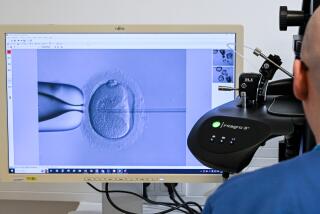From Us to Science -- Three Embryos
- Share via
Just about nine years ago, I nervously picked up the phone and called a fertility clinic in Boston to see if my husband and I had made embryos. We had! After trying -- and failing -- to have a baby any other way, we were on our way to making one via IVF, in vitro fertilization. After weeks of shots that slowed down and then jump-started my ovaries, I had produced a slew of eggs that were extracted while I was under general anesthesia. These were introduced in a petri dish to my husband’s sperm.
Fertilization took place. I was the proud mother of six embryos. We headed from Maine to Boston, where three embryos were transferred into my uterus.
I remember a doctor asking us about the other three embryos, which didn’t appear robust enough to freeze for future attempts at IVF. We had a choice: discard them or donate them to scientific research.
We gave them to science. And I didn’t give them another thought. My heart was wrapped around the three embryos I carried inside me. I’d lie in bed and visualize them nestling into my uterine wall. “Please, just one of you stick around. Or two,” I’d whisper to my little embryos. I pinned my dreams of motherhood to them.
Now, however, those embryos, and others like them, are back on my mind. In fact, I’m hanging my dreams on them.
Those little clumps of cells that held a promise of future parenthood for my husband and me could also hold the potential of good health for people with an array of devastating conditions. That’s because they are the source of stem cells with the remarkable potential of developing into different cell types to repair or replace body systems that aren’t working right.
I have multiple sclerosis, one of the diseases that researchers think they might be able to treat or even cure with stem cells. Here I sit, on either end of embryonic stem cell research, trying to find some connection between my embryos and the research that might help me and countless others with MS, Parkinson’s, Alzheimer’s or other debilitating conditions.
Not every infertile couple has had the chance to donate their extra embryos to science. A ban on federal funding of embryonic stem cell research is probably limiting scientific progress on curing MS and other conditions, in part because researchers who get federal funding are limited to a mere 22 surviving cell lines established in labs before 2001.
Although the House has passed legislation that would free up more embryos for federally funded stem cell research, President Bush has promised to veto it. He and other opponents of embryonic stem cell research say it destroys life.
No one could be more attached to an embryo than a woman who has gone through the heartbreak of infertility and the rigors of IVF to make one. But even while I murmured to my embryos in bed at night, I didn’t really think they could hear me. They weren’t alive. Those were my dreams I was talking to, and the embryos were the building blocks of those dreams. One of them fulfilled its promise, and I gave birth nine months later.
If our leftover embryos hadn’t gone to research, they would have gone into some trash bin for medical waste. Given the dazzling potential in those little clumps of cells, that’s an extraordinary waste, indeed.






